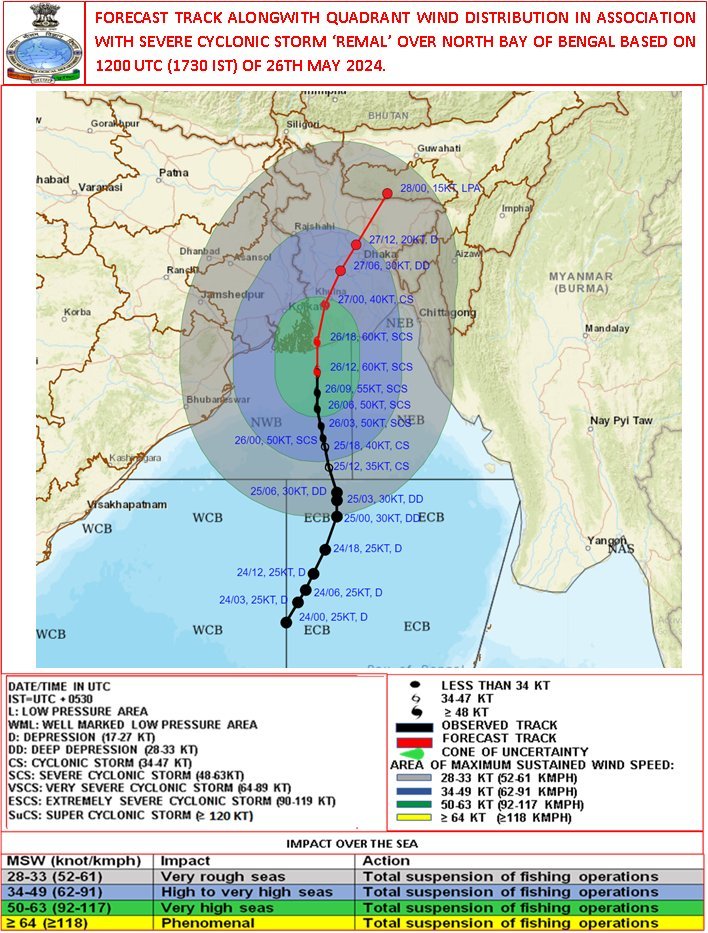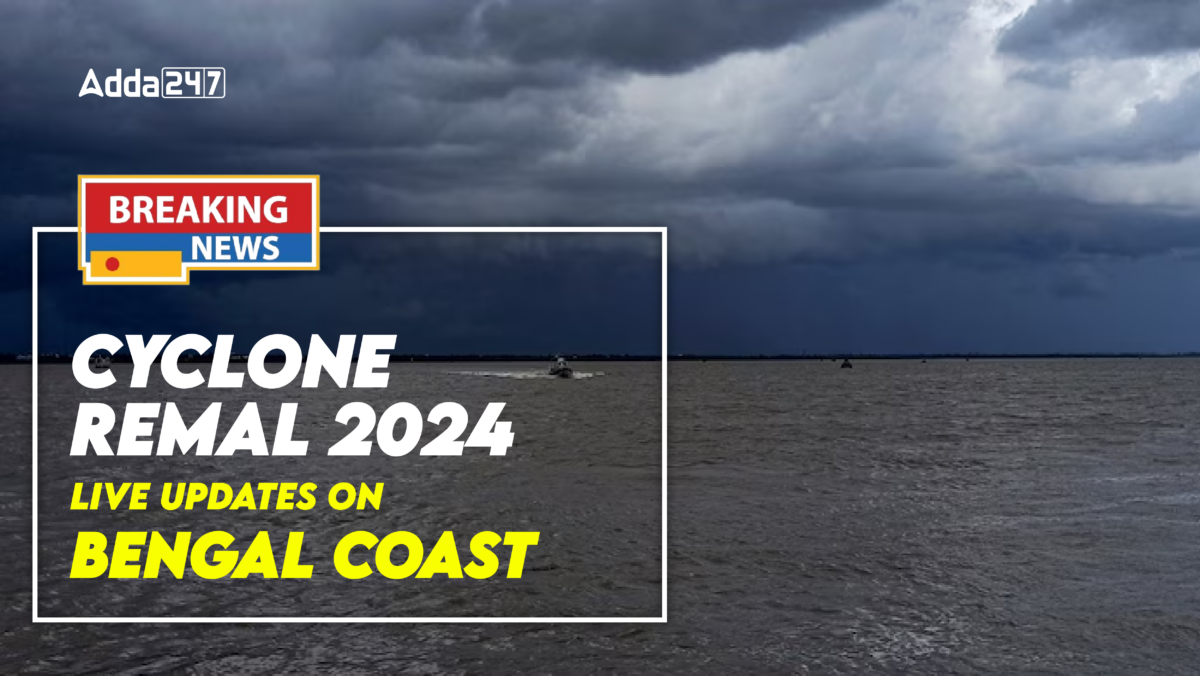Table of Contents
Cyclone Remal 2024 Live Updates- Cyclone Remal is intensifying in the Bay of Bengal and is expected to make landfall on the morning of Sunday, May 26th, near Sagar Islands in West Bengal and the adjoining area of Khepupara in Bangladesh. This is the first cyclone of the pre-monsoon season in the Bay of Bengal.
Live Updates of Cyclone Remal
A developing storm in the Bay of Bengal, soon to be named Cyclone Remal, is expected to hit Sagar Islands in West Bengal and nearby Khepupara in Bangladesh early on May 26, according to the India Meteorological Department (IMD). The storm will bring heavy rain to several districts in West Bengal and north Odisha on May 26 and 27, and extremely heavy rain to parts of northeast India on May 27-28.
Currently, Cyclone Remal Speed is a depression about 660 km south-southeast of Sagar Island and is expected to strengthen into a cyclonic storm by May 25. Fishermen have been advised to stay out of the sea until May 26.
Cyclone Remal Latest Update
Landfall and Wind Speed:
-
Remal Cyclone Landfall area was made between Khepupara in Bangladesh and Sagar Island in West Bengal.
- The India Meteorological Department (IMD) predicts landfall around midnight on Sunday.
- Remal Cyclone Wind speeds are expected to be highest in South and North 24 Parganas districts, reaching 110-120 kmph.
Rainfall:
- Red Alert: Issued for the South and North 24 Parganas coastal districts, expecting hefty rainfall and strong winds.
- Orange Alert: Issued for Kolkata, Howrah, and Purba Medinipur districts, with very heavy rainfall and wind speeds of 80-90 kmph.
- Light to moderate rainfall: Likely to begin on Saturday and intensify through Sunday and Monday.
Affected Areas:
- Coastal districts of West Bengal, particularly South and North 24 Parganas.
- Northern Odisha is likely to experience isolated heavy rainfall and wind speeds of 40-50 kmph.
- Other northeastern states like Mizoram, Manipur, Nagaland, Tripura, and Assam might also see strong winds and increased rainfall.
Live Updates on Cyclone Remal
How are Cyclones Remal?
This year’s first pre-monsoon tropical cyclone in the Bay of Bengal has been named Remal, which means ‘sand’ in Arabic. The name was chosen by Oman and follows the standard convention for naming tropical cyclones in the region.
How people can save from Cyclone Remal
Cyclone Remal is expected to make landfall near Sagar Islands by Sunday morning, bringing very heavy rain and strong winds to coastal districts. Residents are urged to follow evacuation orders and stay informed with the latest IMD updates. Cyclone Remal poses a serious threat to the Bengal Coast. So here is the guide to help people to stay safe from Cyclone Remal:
- Stay Informed: Regularly check updates from the India Meteorological Department (IMD) and local authorities for the latest information on the cyclone’s path, intensity, and warnings.
- Prepare an Emergency Kit: Include non-perishable food (at least a 3-day supply), bottled water, a first-aid kit, medications, important documents (in waterproof containers), a flashlight with extra batteries, portable radio, a whistle, and hygiene items.
- Evacuation Plan: If you live in a flood-prone or weak structure area, identify evacuation shelters and plan your route.
- Stock Up on Essentials: Buy extra groceries, medicines, and fuel as ATMs and shops might be inaccessible after the cyclone.
During the Remal Cyclone:
- Follow Safety Guides: If instructed to evacuate, do so immediately. Don’t delay and prioritize your safety.
- Stay Indoors: If evacuation is not possible, find a safe room on the upper floor away from windows and doors. Interior rooms with no windows are ideal.
- Shelter Under Sturdy Furniture: If you can’t find a safe room, take shelter under a sturdy table or piece of furniture, protecting your head and neck.
- Stay away from windows and doors: Strong winds can shatter glass and cause flying debris.
- Stay off the Roads: Avoid driving or walking during the storm unless necessary. Flooded roads and fallen debris pose serious dangers.
- Turn off Utilities: If safe to do so, switch off electrical mains and turn off gas lines to prevent fires after the storm.
After the Cyclone Remal:
- Stay Alert for Continuing Dangers: Downed power lines, damaged structures, and flooding can pose dangers even after the storm passes.
- Check on Neighbors: Once it’s safe to go outside, check on your neighbours, especially those needing extra assistance.
- Report Damage: Report any damage to your property to local authorities for assistance.
- Be Patient: Restoring power, water, and communication lines may take time. Be patient and cooperate with relief efforts.
Cyclone in Kolkata
Kolkata is on high alert as Cyclone Remal intensifies in the Bay of Bengal. While the cyclone is expected to make landfall near Sagar Islands, it’s predicted to “graze” Kolkata, significantly impacting the city.
Here’s what to expect:
- The India Meteorological Department (IMD) has issued an orange alert for Kolkata, forecasting heavy to very heavy rainfall with a potential for over 200 mm within 24 hours of Cyclone Remal’s landfall.
- Wind gusts could reach up to 100 kmph, posing risks to trees, structures, and power lines, and causing potential flooding in low-lying areas due to heavy rain and storm surges.
Sagar Island
Sagar Island, also known as Ganga Sagar or Sagardwip, is an island located in the Ganges Delta, on the continental shelf of the Bay of Bengal, roughly 100 kilometres south of Kolkata, India.
Sagar Island is a popular tourist destination known for its serene beaches, religious significance, and its unique position at the meeting point of the Ganges River and the Bay of Bengal.
Remal Cyclone Tracker Live Satellite
While there is no such live satellite feed for Cyclone Remal, you can track its progress using these resources:
![]()
- India Meteorological Department (IMD): Visit IMD’s website for satellite imagery and weather updates, including details on Cyclone Remal.
- Tropical Cyclone Tracking: Websites like Cyclocane provide storm tracker pages with Cyclone Remal’s location, wind speed, and predicted path using satellite data.
- News Reports: Reputable news sources often include satellite imagery in their reports on Cyclone Remal.

Note: These resources might not offer a continuous live view but provide crucial updates. Live satellite imagery is processed and may not show the most recent conditions. Rely on official advisories from the IMD for accurate and up-to-date information.



 TSPSC Group 1 Question Paper 2024, Downl...
TSPSC Group 1 Question Paper 2024, Downl...
 TSPSC Group 1 Answer key 2024 Out, Downl...
TSPSC Group 1 Answer key 2024 Out, Downl...
 UPSC Prelims 2024 Question Paper, Downlo...
UPSC Prelims 2024 Question Paper, Downlo...





